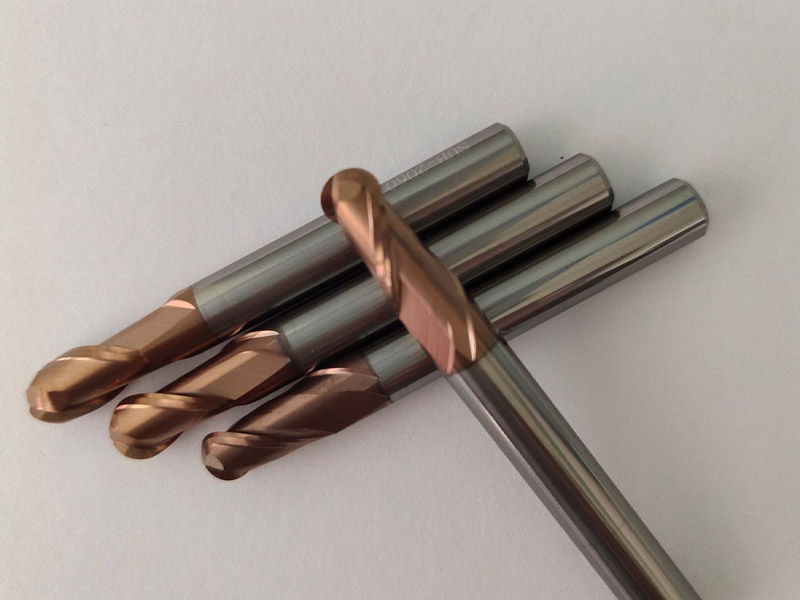
Tool coating: Open a new era of efficient processing
In the fierce competition of machining, tool coating technology is like a bright pearl, which opens up a new world for the improvement of cutting tool performance. Since the advent of hard-coated tools in the early 1970s, the development of chemical vapor deposition (CVD) technology and physical vapor deposition (PVD) technology has completely changed the landscape of the tool industry. Compared with uncoated tools, the advantages of coated tools, like the progress of The Times, have significantly promoted the development of the machining industry.
1. Excellent characteristics of coating
Hardness is the "steel bone" that the coating gives the tool. High surface hardness becomes a solid barrier to extend tool life. In general, the higher the hardness of the material or surface, the stronger the ability of the tool to resist wear and damage during the cutting process, thus extending the service life. CVD diamond coating shines in the field of cutting tools with its amazing surface hardness Hv9000. Compared with PVD coated tools, the life of CVD diamond coated tools is significantly increased by 10 to 20 times. This high hardness and cutting speed is 2 to 3 times higher than that of uncoated tools, making diamond coated tools the best choice for cutting non-ferrous materials, providing a strong guarantee for the improvement of processing efficiency and quality.
Wear resistance, like the "tough shield" of knives. In the cutting process, although the hardness of some workpiece materials themselves may not be too high, the elements added in the production process and the process used may cause damage to the cutting edge of the tool, causing cracking or blunting. The coating with excellent wear resistance can effectively resist this wear and ensure the sharpness and accuracy of the tool. This is one of the key factors that coating tools can still maintain efficient cutting when processing a variety of difficult materials.
The surface lubricity is like the "smooth coat" of the tool. High friction coefficient will increase the cutting heat, resulting in shortened coating life or even failure. The smooth or textured surface of the coating is like a smooth coat for the tool, which helps to reduce the cutting heat. The smooth surface allows chips to quickly slide away from the front cutter surface, reducing heat generation. Compared with uncoated tools, coated tools with better surface lubricity can also be processed at a higher cutting speed, which further avoids high-temperature fusion welding with the workpiece material and improves processing efficiency and quality.
Oxidation temperature is the "patron saint" of the tool in a high temperature environment. The higher the oxidation temperature value, the more favorable it is for cutting under high temperature conditions. TiAlN coatings are particularly good in this regard. Although its hardness may be lower than TiCN coating at room temperature, it can play a huge advantage in high temperature processing. The TiAlN coating retains its hardness at high temperatures because a layer of alumina forms between the tool and the chip. This layer of aluminum oxide acts as a solid defense line to transfer heat from the tool to the workpiece or chip, protecting the tool from high temperature erosion. Therefore, TiAlN has become the coating of choice for carbide tools, and carbide drills and end mills often use this PVD TiAlN coating, which provides a reliable guarantee for high-speed cutting.
Adhesion resistance, like the "isolation film" of the tool. The anti-bonding properties of the coating can prevent or reduce the chemical reaction between the tool and the material to be machined, avoiding the deposition of the workpiece material on the tool. In the processing of non-iron group metals (such as aluminum, brass, etc.), the tool often produces chip nodules (BUE), resulting in tool breakage or workpiece size out-of-tolerance. The coating with good adhesion resistance can effectively avoid this situation even in the processing occasions where the coolant performance is poor or the concentration is insufficient, and ensure the smooth progress of the processing process and the quality of the workpiece.

2 commonly used coating family
Titanium nitride coating (TiN), like an "all-rounder", is a common PVD coating. It can increase the hardness of the tool and has a higher oxidation temperature. Whether it is high speed steel cutting tools or forming tools, very good processing results can be obtained after using TiN coating. It can play a stable role in various processing scenarios, and is a classic in the field of coating tools.
Titanium nitride carbide coating (TiCN) is a "performance enhancer". The addition of carbon elements to the coating acts as an injection of stronger force to the tool, which increases the hardness of the tool and achieves better surface lubricity. TiCN coating is the ideal coating for high-speed steel tools, especially when processing some materials with high hardness and lubrication requirements, it can play its unique advantages, so that the tool is more convenient in the cutting process.
Nitrogen aluminum titanium or nitrogen titanium aluminum coating (TiAlN/AlTiN), called "high temperature processing experts". The alumina layer formed in the TiAlN/AlTiN coating can effectively increase the high-temperature working life of the tool. This makes it the coating of choice for carbide tools in dry or semi-dry cutting processes. Depending on the proportion of aluminum and titanium contained in the coating, AlTiN coatings provide higher surface hardness than TiAlN coatings, making it another favored coating choice for high-speed machining. In the face of high temperature, high speed processing challenges, TiAlN/AlTiN coated tools can demonstrate excellent performance, providing a solid guarantee for processing efficiency and quality.
Nitrogen chromium-aluminum coating (AlCrN) is a "pioneer in anti-bonding". The good adhesion resistance of AlCrN coating makes it the preferred coating for processing where chip nodules are prone to occur. After applying this almost invisible coating, the processing performance of high-speed steel tools or cemented carbide tools and forming tools will be greatly improved. Whether in the processing of difficult materials, or in the case of poor coolant conditions, the AlCrN coating can effectively prevent material adhesion to the tool, ensuring the smooth process and dimensional accuracy of the workpiece.
Diamond coating (Diamond) is undoubtedly the "aristocrat" in the coating family. The CVD diamond coating provides the best performance for tools working with non-ferrous metal materials. It is ideal for processing graphite, metal matrix composites (MMC), high-silicon aluminum alloys and many other highly abrasive materials. However, it should be noted that pure diamond coated tools cannot be used to process steel parts. Because the processing of steel will produce a lot of cutting heat, and lead to chemical reactions, so that the adhesion layer between the coating and the tool is destroyed. The coatings suitable for hard milling, tapping and drilling are different and have their specific applications. In addition, multi-layer coatings can also be used, which have other coatings embedded between the surface layer and the tool base, which can further improve the service life of the tool.
On the stage of machining, tool coating technology is like a magical magician, putting on a magical coat for cutting tools, so that they can show their skills in various processing scenes. From the enhancement of hardness to the enhancement of wear resistance, from the optimization of surface lubrication to the stable protection at high temperatures, the coating tool has brought unprecedented changes and development for the machining industry with its excellent performance. Understanding and mastering tool coating technology and choosing the right coating is an indispensable step for every machine processor in the pursuit of efficient and high-precision processing.



